Summary
- The soybean aphid, Aphis glycines Matsumura, is the only aphid known to extensively colonize soybean fields in North America.
- This pest is a potential threat to virtually all soybeans grown in the US and Canada. However, some states are more at risk of economic infestations than others (Figure 1).
- In addition to geographical considerations, soybean fields at highest risk include those planted late and those that experience hot, dry weather that stresses the crop.
- Because soybean aphid populations can increase rapidly, growers should scout regularly, monitor population levels and be prepared to treat if necessary.
- Soybean aphids have many natural insect enemies such as lady beetles and their larvae that can help keep moderate populations in check. Fungal diseases are also emerging as important factors in aphid population regulation.
- This Crop Insights will address soybean aphid damage, life cycle, response to climate and management. Spraying considerations, Pioneer's antibiosis ratings, biocontrol, insecticide timing and ongoing research are also discussed.

Figure 1. Soybean aphid distribution and area of increased risk.
Introduction
Soybean aphid was first detected in North America near Lake Michigan during the 2000 growing season, and quickly spread to become a major insect pest of soybeans. Annual population levels are determined primarily by weather and interactions of aphids with their natural enemies, particularly the multi-colored Asian lady beetle and entomopthora fungi. The number of aphids present on buckthorn in early spring has often correlated with aphid outbreaks. However, prevailing summer weather patterns also determine if aphids will reach damaging levels.
In high infestation years, growers have managed aphids primarily by scouting and application of insecticides when aphid numbers exceed economic thresholds. Insecticide seed treatments may also provide some measure of early control. In addition, Pioneer researchers have rated Pioneer® brand soybean varieties for their ability to reduce aphid reproduction, and are also working to develop genetic resistance as a future management tool.
Damage to Soybeans
Soybean aphids have needle-like sucking mouthparts, which they insert into soybean tissues to remove plant sap. From the seedling stage until blooming, aphids colonize tender leaves and branches of the plant. Later, the aphids move to the middle or lower parts of the plant, and tend to colonize the underside of leaves as well as the stem. If aphid numbers are high, leaves may become yellow and distorted, the plant may become stunted, and plant parts may be covered with a dark, sooty mold. Yield losses often accompany these symptoms.
The soybean aphid is capable of transmitting viral diseases to soybeans, including alfalfa mosaic, soybean mosaic, bean yellow mosaic, peanut mottle, peanut stunt and peanut stripe. Viruses can cause leaf mottling, various leaf, pod and plant deformities, stunting, and discolored seed. Virus development usually results in yield losses.
Description and Life Cycle
Soybean aphids are small, yellow aphids with distinct black cornicles ("tail-pipes"). At only 1/16th of an inch long (the size of a pinhead or smaller), they cannot be distinguished from other aphids with the naked eye. The soybean aphid is the only aphid in North America known to extensively colonize soybean fields.

Black cornicles help identify soybean aphid.
Soybean aphids overwinter as eggs on a woody shrub species known as buckthorn – Rhamnus davurica and R. cathartica and others of the Rhamnus genus. The eggs hatch in the spring into wingless types, which establish on buckthorn for 2 generations. The third generation emerges, produces wings and migrates to soybean fields and other acceptable hosts in late May to early June. Acceptable hosts include alfalfa, crimson clover, red clover, snap bean, other clovers and some weeds, such as nettles.
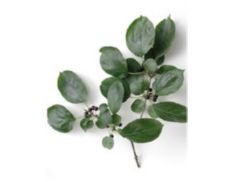
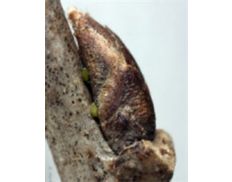
Winter host - Rhamnus sp. Also known as buckthorn (first photo). Soybean aphid overwintering eggs under bud of buckthorn (second photo).
Soybean aphids can produce up to 15 generations during the summer on soybeans before migrating back to buckthorn in the fall as winged females. Once on buckthorn, winged females give birth to wingless females, which mate with males developed on soybeans to produce the overwintering eggs.
Effect of Climate
The environment plays a significant role in the yearly population dynamics of soybean aphids. Favorable overwintering sites and weather increase winter survival and can contribute to localized outbreaks in any given year. Large outbreaks as in 2001 and 2003 are mostly dependent on favorable temperatures during the growing season that allow for rapid reproduction and longer survival periods.
Research conducted by the University of Minnesota suggests temperatures above 95 F (35 C) limit soybean aphid reproduction and reduce the length of survivorship of any individual aphid to less than 10 days. Ideal temperature conditions of 77 F to 82 F (25 C to 28 C), on the other hand, allow soybean aphids to live for 20 or more days and maximize reproduction. This research and experience in the past few years indicates that temperature plays a major role in the doubling time of aphid populations and ultimately determining if they become a serious pest. Average temperatures between 75 F and 85 F (24 C and 29 C) can create a population doubling time of less than 2 days with high survival rates; temperatures above 90 F (32 C) result in doubling time of 1 week or more and low survival.
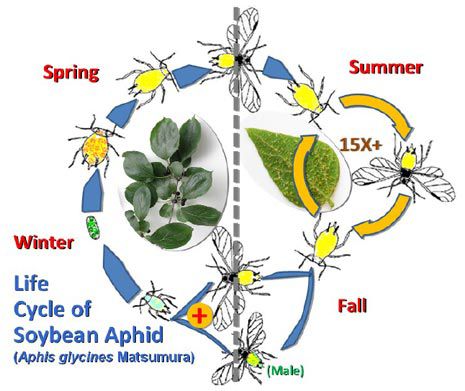
Life cycle of the soybean aphid (author David Voegtlin).
- Late fall thru early spring is spent on buckthorn
- Late spring until fall is spent on soybean
- All individuals are female, except briefly in the fall
- All reproduction is parthenogenetic (clones) until after mating on the winter host
- Winged individuals are produced for moving between hosts and for dispersal during the summer
- Winter survival is as an egg under buckthorn leaf buds
Favorable climate also enhances migration and movement of soybean aphids. Typical migration of winged soybean aphids has been documented at 3 to 6 miles per day. But experience from 2001 and 2003 suggests that strong upper air currents from fronts and storm systems carry soybean aphids much longer distances, resulting in widespread infestations during large outbreak years.
Managing Soybean Aphids
Management decisions regarding soybean aphids are difficult due to the explosive potential of aphid populations and the interaction of aphids with climatic conditions and natural predators. Careful scouting is absolutely necessary to determine if treatment is needed and to time insecticide treatments to maximize their effectiveness.
Scouting
Soybean aphids tend to develop most quickly on vegetative stage soybeans, and their development slows on flowering / reproductive stage soybeans. The recommended time to begin scouting is when soybeans are in the late vegetative stage (usually late June/early July in Midwest states). Growers should continue their watch through preflower and flowering stages and treat if aphids reach the economic threshold.

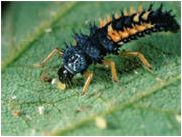
Abundance of lady beetles (first photo) or their larvae (second photo) are often indicative of soybean aphid populations. These and other natural predators help control moderate infestations.
Economic Threshold
An economic threshold (ET) for the R1 to R5 growth stages is currently established at 250 aphids/plant (average of 20 to 30 plants per field) if populations are increasing. If this threshold is reached, treating within 7 days is required to prevent populations from reaching the Economic Injury Level (EIL) where yield loss exceeds the cost of treatment. Scouting guidelines are shown in the sidebar. A "speed scouting" or sequential sampling method has also been developed that can save time when the decision is relatively clear cut: "Scouting for Soybean Aphid" from University of Minnesota Extension.

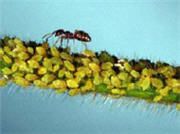
Soybean aphids colonizing leaves (left) and stem (right) of soybean plant are at economic levels in these pictures.
Research studies have shown that insecticide application can be a useful strategy for reducing yield loss due to soybean aphids. Furthermore, careful timing of applications was found to be important to help minimize losses. Results are reported below for studies conducted in the large outbreak years of 2001 and 2003.
Research on Insecticide Application and Timing
Field-sized insecticide trials were established in 2001 in 73 locations and again in 2003 in 103 locations, in several northern states where the soybean aphid had exceeded economic thresholds. When the results were grouped by spray date, the data reveal that highest yield increases were obtained when spraying occurred from mid-July through the first days of August in both cases (Figure 2). Treatments applied beyond this timeframe resulted in less yield response.
In 2001 less response occurred after August 10 while in 2003 the beneficial response lasted until August 20.
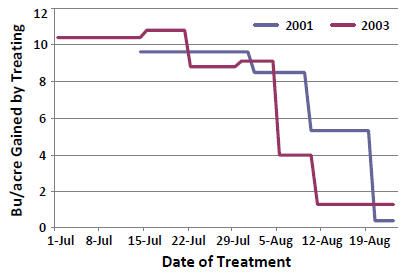
Figure 2. Soybean yield response to insecticide timing, 2001 and 2003 combined data. Source: Pioneer.
This demonstrates that soybean growth and development, weather patterns and aphid population dynamics can change from year to year. Growers should time spray applications based on soybean growth stage and careful scouting of each field, rather than on the calendar date. Differences in weather, including both temperature and moisture, will affect both the aphids as well as the growth of the plant and ultimately the population dynamics. Each year will be unique.
The soybean aphid actually grows and reproduces better under cooler temperatures; however, under hot, dry conditions, affected fields are at a much higher risk of yield loss due to soybean aphids. Drought places soybeans under stress, which can magnify the effects of aphid feeding. Just as importantly, pathogenic fungi may not establish on aphid colonies during hot, dry weather, allowing aphid populations to explode when cooler temperatures return. Spider mites may also establish on soybeans during hot, dry conditions, which further stresses the plant and compounds the aphid problem.
Aphid Reproduction Facts
- All spring and summer offspring are female, are born pregnant, and give live birth. Birth rate is 3 to 8 per day for 10 to 40 days.
- Generation time is typically 7 to 10 days. Populations can double in 1.4 to 1.9 days.
- Up to 15 generations may occur per season on soybeans. Aphids can disperse 3 to 6 miles per day.
Scouting Guidelines
- Entomologists suggest sampling 5 to 10 areas of the field (covering 80% of the field) and examining a total of 20-30 plants per field.
- See specific guidelines in your state.
Early Season Scouting Tips
Scout along tree lines and field edges. Look for:
- Aphids on the underside of the upper leaves
- Ants tending aphid colonies
- Presence of lady beetles and larvae
Midseason Scouting Tips
Look for:
- Presence of honeydew and sooty mold.
- White "skins" remaining after aphids molt
- Crowding and movement into lower canopy
Conditions Favoring Aphid Reproduction/Survival
- Mild Winters
- Favorable Overwintering Sites
- Wooded areas with buckthorn species
- Favorable Summer Host Plants
- Soybeans - Alfalfa - All Clovers
- Moderate Summer Temperatures
- Optimum temperature for aphids is ~ 82 F (28 C) with temperature range from 68 F to 86 F (20 C to 30 C).
- Temperatures of 95 F (35 C) and above limit reproduction and survival
Conditions Favoring a Treatment Response
- Crop development stage at early flower to seed set
- Aphid levels increasing
- Weather favorable for aphid reproduction/survival
- Late-planted soybean fields
- Lack of beneficial insects
- Absence of parasitic fungi
Spraying Considerations
Soybean aphids feed primarily under soybean leaves, or on stems and pods contained within a very dense canopy of soybean foliage. This environment makes it challenging to deliver insecticide sprays directly onto the aphids.
Coverage - For optimal control of aphid populations, use high pressure and high volume of carrier to achieve thorough coverage and penetration of the crop canopy. Research by the University of Minnesota suggests that either ground or aerial applications are effective methods.
- Ground Applications - Use 20 to 40 gallons of carrier per acre and 30 to 60 PSI.
- Air Applications - Use 3 to 5 gallons of carrier per acre.
Timing Applications - It is important that each field be thoroughly scouted before a treatment is applied. When timing insecticide applications, consider the aphid population dynamics, crop stage and climatic conditions. It is important to note that chemical applications made during vegetative stages will likely result in re-infestations at levels higher than adjacent areas not previously treated. Applications should be delayed until economic thresholds are attained.
Tank Mixing With Herbicides - Coverage and timing are key. Adding an insecticide as a tank-mix partner with an early herbicide application may reduce beneficials and may not correspond with optimal timing for either the weed or the insect pest.
Preharvest Interval - The preharvest interval (PHI), of insecticides labeled for soybean aphid ranges from 21 to 60 days. Applications made in late July and into early August will require an insecticide with a very short preharvest interval, particularly with early maturity soybean varieties.
Caution - Some insecticides are extremely toxic to fish and aquatic invertebrates. Use caution when applications are made to any area adjacent to a body of water.
Foliar Insecticides Labeled for Soybean Aphids
Insecticides labeled and commonly used for foliar application and control of soybean aphid are listed below (label may refer to soybean aphid or Chinese aphid). See labels for additional information on use of these insecticides. (Product labels may change – always read and follow label instructions.)
Table 1. Insecticides1 labeled and most commonly used for control of soybean aphids in soybeans.

All these products are restricted-use insecticides.
Always read and follow product label directions.
1Insecticides listed as suppressing soybean aphid are not included. For more info see: "Insect Almanac-Soybean Insects" from the University of Nebraska-Lincoln Dept. of Entomology
2Restricted Entry Interval. Entry into treated field within this interval requires protective clothing and gear specified on label.
3Preharvest Interval. Do not apply insecticide during this period.
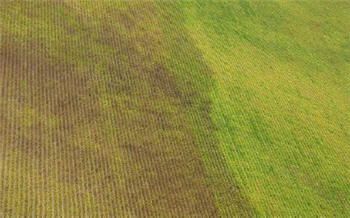
Aerial picture of unsprayed (left) vs. sprayed (right) field areas demonstrates the dramatic effect of soybean aphids and the benefit of treating.
Insecticide Seed Treatments for Soybean Aphid
In addition to foliar application of pesticides for control of soybean aphid, other methods may have some application. Insecticide seed treatments such as the Pioneer® brand soybeans with Gaucho® or Cruiser® insecticide, both of which are available as components of Pioneer Premium Seed Treatment offerings, have been labeled for soybean aphid control and have shown some efficacy especially when fields are planted late. Soybean aphids do not immediately move from the overwintering host to soybean fields. This means use of a seed treatment for early planting may not be as effective as for late planting, as natural degradation of the insecticide will reduce effectiveness over time. However, seed treatments have been shown to provide effectiveness in delaying aphid increase, especially in late-planted situations. One would expect them to also have an effect on establishment of beneficials; however this effect has not been extensively studied at this time.
Soybean Antibiosis Ratings -- A Helpful Management Tool from Pioneer
Pioneer, in collaboration with Kansas State University, has developed a technique for screening soybean lines for their ability to naturally reduce the rate of growth, survival and reproduction of soybean aphids that feed on soybean plants. This type of resistance is called “antibiosis”. Antibiosis is measured by comparing the rate of aphid reproduction on different varieties. Pioneer soybean breeders are utilizing these breakthrough techniques to:
- Characterize current Pioneer® brand soybean varieties for their aphid antibiosis (a natural ability to ward off the pest by reducing its life span or inhibiting its reproduction).
- Identify sources of exceptional antibiosis and incorporate this trait into new Pioneer varieties.
Pioneer has provided aphid antibiosis ratings for its soybean varieties for several years. To obtain antibiosis ratings on Pioneer® brand soybean varieties, see your local Pioneer sales professional or visit the soybean products section.
How to Use Aphid Antibiosis Ratings for Pioneer Brand Soybean Varieties
- Because no soybean varieties currently on the market offer complete resistance to aphids, it's important that growers have a clear understanding of what aphid antibiosis ratings mean and how to practically utilize them. Using them correctly can save time and lead to more accurate decision making.
- An "Exceptional" antibiosis rating for a variety does not mean that aphids will not attack or damage the soybean plant. The ratings are relative comparisons and according to our screening and characterization studies, aphids will reproduce faster on varieties rated "Below Average" or "Average" than they will on varieties with "Exceptional" or "Above Average" ratings.
- Because antibiosis rating is not correlated with ability to yield and because potential for aphid infestation is not predictable at planting, growers should not choose varieties for planting using the Aphid Antibiosis Rating.
- Aphid antibiosis ratings should instead be used by growers to help in determining field scouting priorities and insecticide application decisions should an infestation of soybean aphids occur. For example, when aphid scouting is recommended in an area, fields planted to a variety with a "Below Average" rating should be scouted first and with greater frequency than fields planted to varieties with "Average", "Above Average" or "Exceptional" scores. Growers should use those varieties with Below Average ratings as early warning indicators for need to scout more widely.
- Growers should use these antibiosis ratings as an aphid management tool along with diligent scouting, timely insecticide application, and other recognized practices.
Biological Control of Soybean Aphids
In its native region of Asia, soybean aphid is rarely abundant because it has numerous natural enemies that attack and keep it in check. USDA and university scientists are interested in increasing natural enemies in North America as well. Their specific goal is to introduce exotic parasitoids that become established (survive and reproduce) in the Midwest and hold down aphid populations year to year. Successful examples of classical biocontrol in the US include the introduction of parasitoids to control cereal leaf beetle and alfalfa weevil. Both of these non-native insects are now effectively suppressed by biological control, and rarely have to be managed by growers.
After extensive testing, the USDA and land-grant researchers began releasing a host-specific parasitoid of soybean aphid called Binodoxys communis in 2007 and 2008. States participating in the release were South Dakota, Minnesota, Iowa, Wisconsin, Indiana, Michigan and Illinois. This insect is a tiny, stingless wasp – about half the size of a grain of rice – that helps control soybean aphid populations in parts of Asia where both species naturally occur. The parasitoid wasp lays its eggs inside or on the soybean aphid and when the eggs hatch the larvae consume the living host from within. Scientists are closely monitoring the activity, survivability, and population levels of this organism over the next few years and will also test other biocontrol agents.
Ongoing Research on Soybean Aphids
Entomologists are continuing to closely study the soybean aphid as well as monitor infestation levels. Research is being conducted to better understand the life habit of this pest, identify natural enemies and monitor their effect on the aphids, determine the potential yield loss from aphid infestations, and evaluate the effectiveness of insecticides and other management practices. Universities are also conducting field surveys to determine aphid presence and using traps to monitor movement from buckthorn to soybeans.
Pioneer researchers and others have identified several sources of single gene resistance to the soybean aphid. These are known as the Rag genes. These genes as well as native genes with antibiosis and antixenosis (avoidance) properties are targets of Pioneer breeders improving soybean aphid resistance in Pioneer® brand soybean varieties.
Because of the unpredictable nature of soybean aphid infestations, it is very important to Pioneer and its customers that such products be able to stand alone as a top-performing product even when aphids are not a factor. Growers are encouraged to stay in contact with their Pioneer sales professional for updated information on diagnosing and managing soybean aphids in their area.
Aphid Management Guidelines in Brief
- Consider using seed treated with an insecticide seed treatment to delay soybean aphid population establishment.
- Know the antibiosis rating of your Pioneer brand soybean varieties and use those with the lowest rating as indicators for population increase.
- If soybeans have not yet reached R6 (full seed stage) in August and populations average over 250 per plant and still increasing, consider using an aerial insecticide application.
- Continue to scout and reapply if necessary.
More Information
- Soybean Aphid (Aphis glycines). Soybean Research & Information Initiative, a North Central Soybean Research Program.
- University of Wisconsin - Soybean Plant Health.
- North Central IPM Regional Soybean Aphid Suction Trap Network.
- ¹Agronomy e-Business Information Manager. Agronomy Sciences Department. Pioneer Hi-Bred. Johnston, Ia.
- ²Agronomy Information Manager. Agronomy Sciences Department. Pioneer Hi-Bred. Johnston, IA.